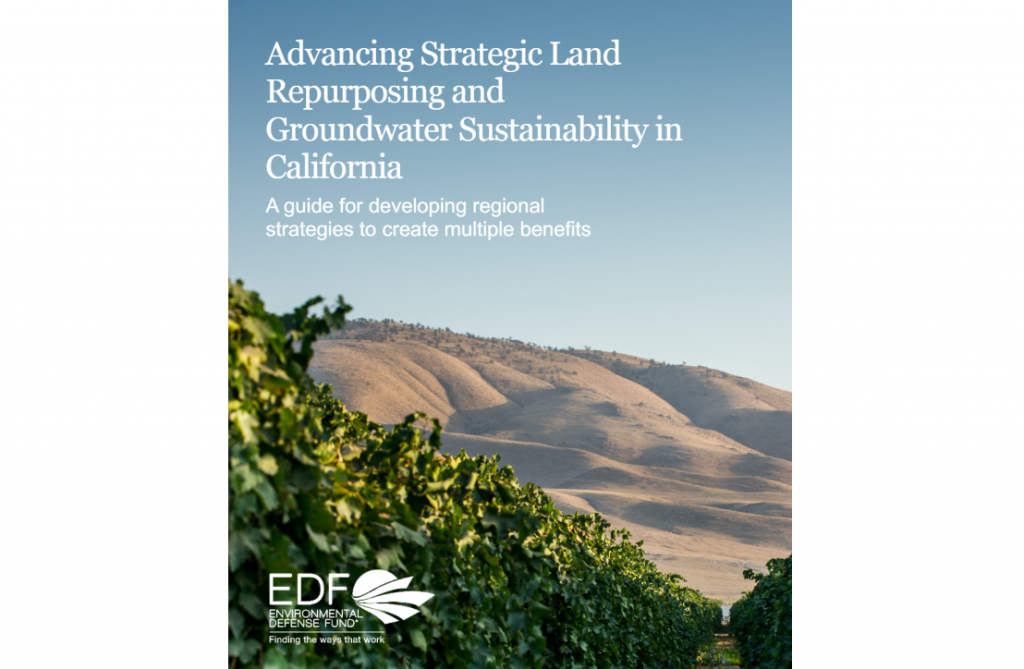Over the coming decades, California’s San Joaquin Valley will transition to sustainable groundwater management under the Sustainable Groundwater Management Act (SGMA), ensuring reliable groundwater supplies for generations to come. Sustainable groundwater management and a changing climate will inevitably affect how land is used on a sweeping scale.
By some estimates, the amount of farmland that will have to be taken out of production to balance groundwater demand and supply is equivalent to the size of Yosemite National Park — a transition that could serve a huge blow to the agricultural economy, rural communities and the environment. At the same time, farmers are also facing steep declines in surface water supplies from rivers and melted snowpack, largely driven by climate change, as they learned just this week.
EDF is hosting a webinar on the white paper findings from 10:30 a.m. to noon on April 6, including a panel discussion with local stakeholders. Sign up here.
To help groundwater sustainability agencies (GSAs), local governments, rural communities and land use planners facing these challenges, Environmental Defense Fund worked with a broad group of stakeholders to develop a new guide, Advancing Strategic Land Repurposing and Groundwater Sustainability in California.
Here are some key perspectives on why strategic land repurposing is so important to creating a more resilient future for the San Joaquin Valley, along with some proposed solutions.
Giving landowners more options
“As SGMA reduces water availability, programs that facilitate other economic uses for retired farmland and provide resources to help manage the land will reduce the economic burden of this transition on agricultural communities.” — Emmy Cattani, Cattani Farms
The white paper outlines several voluntary options for landowners to earn revenue from repurposing farmland and potential funding sources.
For example, landowners could receive one-time per-acre payments for repurposing farmland to habitat for endangered, threatened or at-risk species, with funding coming from public agencies or private developers that need to mitigate the environmental impacts of their projects. Other minimal water use alternatives include cover crop planting, managed grazing and low-impact solar.
EDF is also sponsoring state legislation to create a new program that would pay landowners who voluntarily and strategically repurpose some portion of their agricultural land for at least 10 years to other less-water-intensive uses that create multiple new benefits, including wildlife habitat and open spaces for nearby communities.
Improving the health of residents
“Residents that we work with experience the worst air quality and drinking water issues in the San Joaquin Valley, and have been advocating for years to address those issues. Now that we are rethinking how to use our land and water resources in a sustainable way, we must look to residents’ expertise to help shape land repurposing programs in a way that prioritizes the health and safety of all communities.” — Amanda Monaco, Leadership Counsel for Justice and Accountability
Land repurposing strategies should be co-developed with both potential participants and others who may be affected, including those previously left out of decision-making like low-income rural community residents, small farmers and farmers of color.
Broad, ongoing community engagement that includes marginalized and underrepresented groups is essential. It will help achieve regional goals, avoid potential disproportionate impacts on already overburdened communities and create landscapes that support everyone who lives in the valley.
The white paper includes guiding principles for equitable engagement to help overcome language, geographic, technological and other barriers.
New resource offers helpful guidance for local leaders and stakeholders in California on how to repurpose lands to create a resilient future and ease the transition to sustainable water supplies. Share on XVision and collaboration are key
“Bringing together stakeholders to create a holistic vision of what our region can become is a critical first step toward repurposing some agricultural land to create benefits for farmers, farm workers and the community as a whole.” — Mike Hagman, East Kaweah Groundwater Sustainability Agency
Starting by creating a locally defined vision of what can be achieved through strategic land repurposing — such as better air quality, enhanced biodiversity, community green space and water security — can help ensure success.
While the process can often best be coordinated through a groundwater sustainability agency or other local land use agency, developing a comprehensive land repurposing strategy is likely too big and complex a task for any one agency. To be successful, it will require coordination and collaboration among diverse stakeholders, existing grant programs and multiple agencies.
Given the challenges that are ahead for the San Joaquin Valley, this white paper offers helpful guidance for local leaders and stakeholders on how to ease the transition and repurpose lands to create a more resilient future for agriculture, communities and wildlife .











One Comment
Girl of power and doom